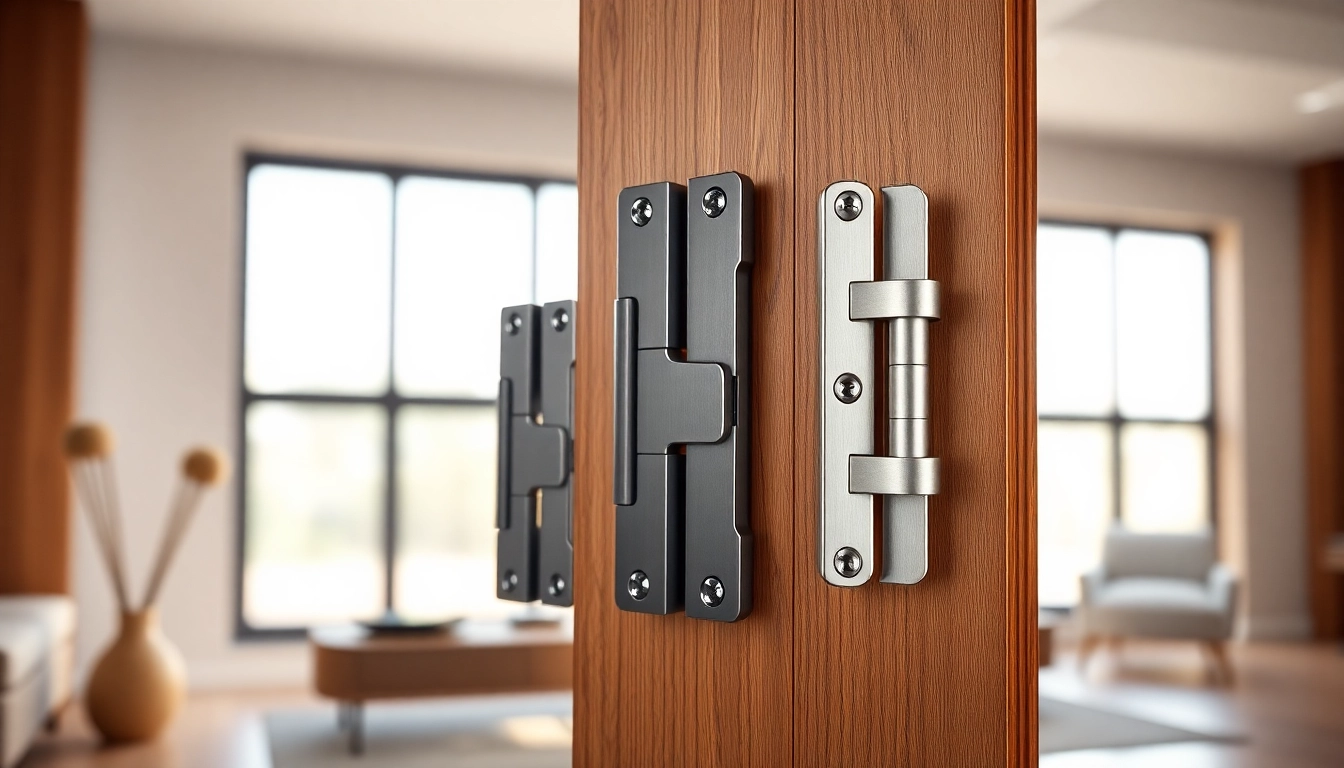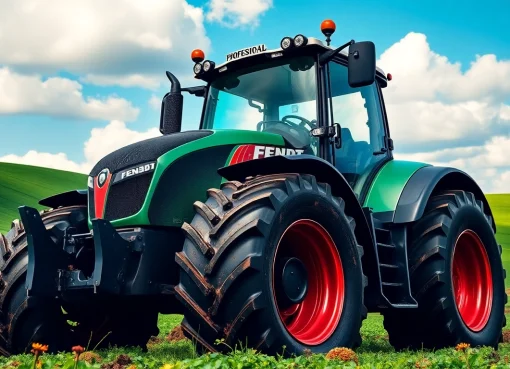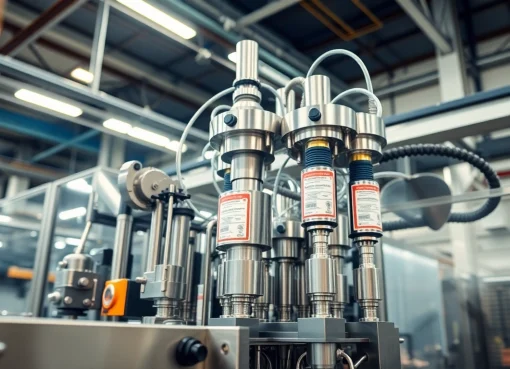Elevate Your Spaces with Premium Door Hinges Manufacturer Solutions

Understanding Door Hinges: Types and Applications
Common Types of Door Hinges
Door hinges are critical components in the construction and functionality of doors. They allow for the smooth operation of the door, providing both stability and flexibility. There are several common types of door hinges, each designed for specific applications:
- Butt Hinges: The most common type, butt hinges consist of two plates (leaves) connected by a pin and are usually mounted on the door and the frame. They come in various sizes and finishes, making them versatile for any requirements.
- Continuous Hinges: Also known as piano hinges, these run the full length of the door. They distribute weight evenly and are commonly used in heavy doors or where durability is essential.
- Mortise Hinges: Designed for flush installation, mortise hinges require a pocket to be cut into the door and the frame. They are often used in high-end installations for aesthetics and strength.
- Spring Hinges: These hinges contain a spring mechanism that allows doors to close automatically, making them suitable for commercial applications like bathrooms and fire exits.
- Ball Bearing Hinges: Featuring ball bearings between the hinge plates, these provide smoother motion and are ideal for heavy or frequently used doors, reducing friction and wear.
Applications Across Various Industries
Door hinges play a critical role across multiple industries and applications, including:
- Residential: Used in homes, hinges must balance aesthetics and functionality. Options like decorative hinges contribute to the style of a home, while practical types ensure doors operate smoothly.
- Commercial: Commercial buildings require heavy-duty hinges capable of enduring frequent use. Options like continuous and ball-bearing hinges are often deployed to manage the stress of high traffic.
- Industrial: In warehouses and manufacturing settings, industrial doors may require specialized hinges capable of supporting extreme weights and environmental elements.
- Automotive: Hinges in vehicles, including trunk and hood hinges, must be lightweight yet sturdy, designed for optimal movement and durability under varying conditions.
- Aerospace: Aerospace applications require hinges that can withstand high pressures and temperatures, calling for advanced materials and precision engineering.
Choosing the Right Hinge for Your Needs
With so many options available, selecting the right hinge involves several considerations:
- Weight Rating: Ensure the hinge can support the weight of the door. Heavier doors require sturdier hinges, typically those rated for at least 150 pounds.
- Material: Choose hinges made of materials suited for the environment. Stainless steel resists rust, while brass offers aesthetic strength.
- Style: Consider the decorative aspect of the hinge and its relevance to the overall design of the door and space.
- Usage: Assess how frequently the door will be used to determine if a more robust hinge is necessary.
Quality and Durability in Door Hinges Manufacturing
Materials Used in High-Quality Hinges
The quality and durability of door hinges often come down to the materials used in their manufacture. Various materials, including stainless steel, brass, bronze, and zinc, offer different strengths and applications:
- Stainless Steel: Known for its corrosion resistance and strength, stainless steel is suitable for both indoor and outdoor applications.
- Brass: A traditional choice for its aesthetic appeal and moderate resistance to corrosion, brass is usually found in residential settings.
- Bronze: With excellent durability and resistance to corrosion, bronze is ideal for marine applications.
- Zinc: Often used in budget models, zinc hinges offer lightweight solutions but may lack longevity in harsher environments.
Testing and Certification Standards
High-quality hinges undergo rigorous testing to ensure they meet industry standards. Various certifications, such as ANSI (American National Standards Institute) and BHMA (Builders Hardware Manufacturers Association), help customers identify reliable products. Common tests include:
- Fatigue Testing: Assesses how well a hinge performs under repeated stress.
- Corrosion Testing: Measures a product’s resistance to rust and deterioration in harsh conditions.
- Load Testing: Ensures the hinge can handle specified weights without bending or breaking.
Benefits of Investing in Durable Hinges
Investing in durable door hinges can provide significant long-term benefits:
- Longevity: High-quality hinges last longer, resulting in reduced replacement costs and maintenance.
- Enhanced Functionality: Durable hinges operate smoothly, ensuring doors open and close effortlessly.
- Safety: Reliable hinges minimize the risk of door malfunctions, improving safety in both residential and commercial spaces.
- Aesthetic Value: Well-manufactured hinges add to the overall visual appeal of doors and can enhance the value of property.
How to Select the Best Door Hinges Manufacturer
Key Factors to Consider
Selecting the right door hinges manufacturer is crucial. Here are essential factors to consider:
- Expertise: Choose a manufacturer with a proven track record in producing reliable and high-quality hinges.
- Material Quality: The manufacturer should source high-quality raw materials and adhere to stringent quality control processes.
- Customization Capabilities: A capable manufacturer should offer options for customization in terms of size, finish, and design.
- Market Reputation: Research the manufacturer’s reputation through reviews, case studies, and testimonials.
Evaluating Manufacturer Reputation
When searching for a reliable hinge manufacturer, evaluating their reputation within the industry is essential. Consider:
- Customer Feedback: Reviews and testimonials from previous clients can provide insight into the manufacturer’s quality and service.
- Industry Partnerships: Reputable manufacturers often partner with well-known companies or organizations in the building and construction industry.
- Awards and Recognition: Any accolades received can serve as indicators of quality and innovation within the manufacturing process.
Comparison of Pricing and Quality
While price is an important factor, the old saying ‘you get what you pay for’ holds true in hinge manufacturing. Always perform a value assessment, considering:
- Cost vs. Quality: Assess whether the lower cost correlates with reduced quality and longevity.
- Long-Term Value: Calculate the total cost of ownership, including potential replacements and maintenance.
- Warranties and Guarantees: A solid warranty indicates manufacturer confidence in their products and can offer peace of mind to customers.
Customization Options for Door Hinges
Finishes and Designs Available
Customization is essential for ensuring door hinges meet specific aesthetic and functional needs. Manufacturers often offer various finishes and designs, including:
- Polished Brass: Adds an elegant touch to residential doors.
- Black Powder Coat: Offers a modern and sleek look, suitable for contemporary designs.
- Stainless Steel Brushed Finish: Provides a clean, industrial appearance while offering durability.
- Antique Finishes: Ideal for vintage or rustic-style homes.
Tailoring Hinges for Specific Applications
A manufacturer should be able to customize hinges tailored for specific purposes, enhancing user experience and functionality. Examples include:
- Custom Sizes: Tailoring hinge dimensions for unique door applications, especially in historical restorations.
- Specialty Features: Incorporating unique features such as self-closing mechanisms or enhanced security options for specific environments.
- Color Matching: Ensuring hinges match the door or surrounding hardware for aesthetic consistency.
Working with Manufacturers for Custom Solutions
Collaborating directly with manufacturers can simplify the customization process. Important steps include:
- Define Requirements: Clearly outline your needs, including the desired application, weight, and load requirements.
- Prototype Testing: Request samples or prototypes to assess functionality before finalizing the order.
- Clear Communication: Maintain open lines of communication throughout the customization process to address arising issues promptly.
Future Trends in Door Hinges Manufacturing
Innovative Materials and Technology
As technology progresses, new materials and processes emerge in hinge manufacturing. Some trends include:
- Lightweight Alloys: Innovations in materials allow for lighter yet stronger hinges, ideal for industrial applications.
- Smart Hinges: The integration of technology into hinges, facilitating automatic closing or operational sensors.
- Biodegradable Materials: An interest in eco-friendly and sustainable materials is growing, appealing to environmentally conscious consumers.
Environmental Sustainability in Production
Sustainable practices in door hinge manufacturing are becoming increasingly important. As more companies prioritize eco-friendliness, trends emerge:
- Recycling of Materials: Many manufacturers are adopting processes that allow the recycling of metals and other materials to reduce waste.
- Energy-Efficient Manufacturing Processes: Utilizing renewable energy sources can decrease the overall carbon footprint during production.
- Reduced Packaging Waste: Emphasizing minimal, recyclable packaging helps companies enhance their sustainability profile.
Predictions for Market Growth and Changes
The door hinge manufacturing market is projected to grow in the coming years due to several factors:
- Increase in Urbanization: As urban areas expand, the demand for quality door hardware will naturally increase.
- Rising Construction Activities: A surge in residential and commercial construction projects globally will boost hinge demand.
- Technological Advancements: Continuous innovation in designs and function will open new markets and create customer interest.



Leave a Comment